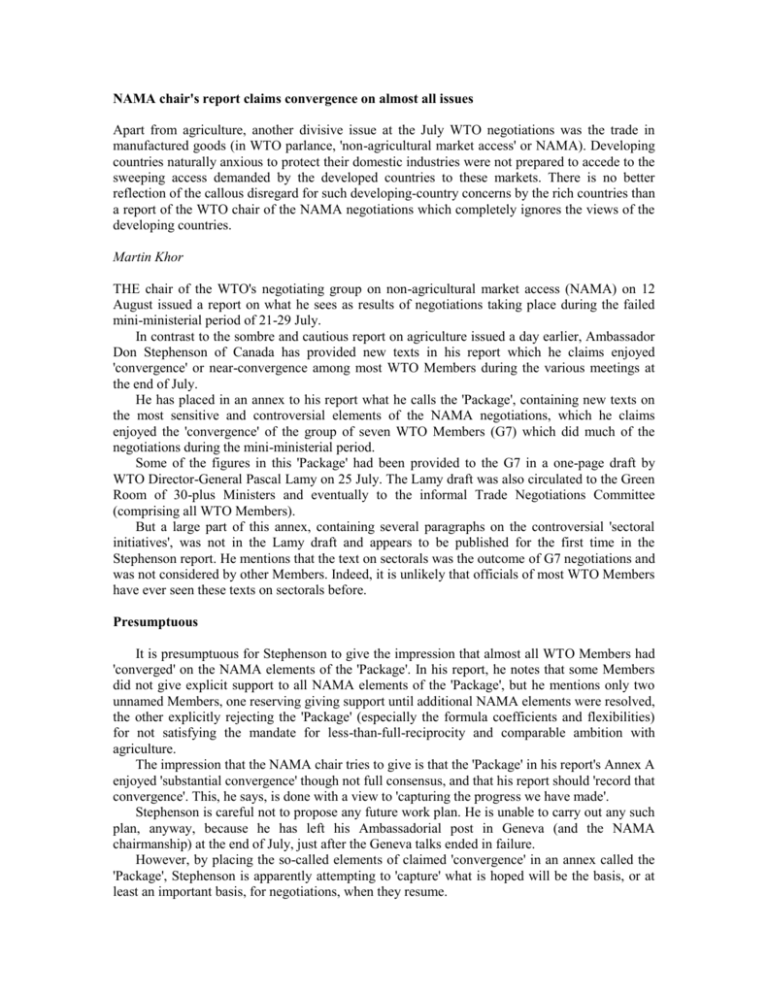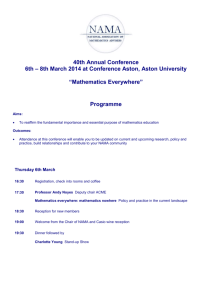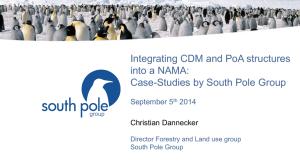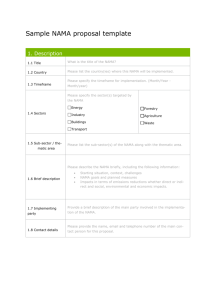NAMA chair`s report claims convergence on almost all issues
advertisement

NAMA chair's report claims convergence on almost all issues Apart from agriculture, another divisive issue at the July WTO negotiations was the trade in manufactured goods (in WTO parlance, 'non-agricultural market access' or NAMA). Developing countries naturally anxious to protect their domestic industries were not prepared to accede to the sweeping access demanded by the developed countries to these markets. There is no better reflection of the callous disregard for such developing-country concerns by the rich countries than a report of the WTO chair of the NAMA negotiations which completely ignores the views of the developing countries. Martin Khor THE chair of the WTO's negotiating group on non-agricultural market access (NAMA) on 12 August issued a report on what he sees as results of negotiations taking place during the failed mini-ministerial period of 21-29 July. In contrast to the sombre and cautious report on agriculture issued a day earlier, Ambassador Don Stephenson of Canada has provided new texts in his report which he claims enjoyed 'convergence' or near-convergence among most WTO Members during the various meetings at the end of July. He has placed in an annex to his report what he calls the 'Package', containing new texts on the most sensitive and controversial elements of the NAMA negotiations, which he claims enjoyed the 'convergence' of the group of seven WTO Members (G7) which did much of the negotiations during the mini-ministerial period. Some of the figures in this 'Package' had been provided to the G7 in a one-page draft by WTO Director-General Pascal Lamy on 25 July. The Lamy draft was also circulated to the Green Room of 30-plus Ministers and eventually to the informal Trade Negotiations Committee (comprising all WTO Members). But a large part of this annex, containing several paragraphs on the controversial 'sectoral initiatives', was not in the Lamy draft and appears to be published for the first time in the Stephenson report. He mentions that the text on sectorals was the outcome of G7 negotiations and was not considered by other Members. Indeed, it is unlikely that officials of most WTO Members have ever seen these texts on sectorals before. Presumptuous It is presumptuous for Stephenson to give the impression that almost all WTO Members had 'converged' on the NAMA elements of the 'Package'. In his report, he notes that some Members did not give explicit support to all NAMA elements of the 'Package', but he mentions only two unnamed Members, one reserving giving support until additional NAMA elements were resolved, the other explicitly rejecting the 'Package' (especially the formula coefficients and flexibilities) for not satisfying the mandate for less-than-full-reciprocity and comparable ambition with agriculture. The impression that the NAMA chair tries to give is that the 'Package' in his report's Annex A enjoyed 'substantial convergence' though not full consensus, and that his report should 'record that convergence'. This, he says, is done with a view to 'capturing the progress we have made'. Stephenson is careful not to propose any future work plan. He is unable to carry out any such plan, anyway, because he has left his Ambassadorial post in Geneva (and the NAMA chairmanship) at the end of July, just after the Geneva talks ended in failure. However, by placing the so-called elements of claimed 'convergence' in an annex called the 'Package', Stephenson is apparently attempting to 'capture' what is hoped will be the basis, or at least an important basis, for negotiations, when they resume. Consistent with his past track record, with the many reports and drafts he has issued through the years of his chairmanship, Stephenson highly and misleadingly exaggerates the degree of agreement that WTO Members have with the last draft modalities text that he issued on 10 July, as well as the degree of 'convergence' with the so-called Package that he says resulted from the mini-ministerial period. While saying the obvious, that his 10 July draft was not a 'consensus text', he continues: 'Having said that, there is much in that text on which there is very substantial convergence. Indeed, on the basis of my consultations with Members, I believe that all of the provisions of the 10 July text could achieve consensus as they were presented in the text, with the exception of those modalities on which I report below.' In a section on 'issues on which there was little or no convergence', he lists additional flexibilities for South Africa, the treatment for Venezuela, small, vulnerable economies (SVEs) and recently acceded members (RAMs), special treatment for Oman, and product coverage. In other words, he implies that except for these exceptional cases of flexibilities and proposed special treatment for individual countries and specific groupings, there is near-consensus or achievable consensus on all other provisions of his 10 July text. Fierce objections This is a very tall claim indeed, given the high degree of controversy, dissatisfaction and anger that has swirled around his core 10 July proposals of the Swiss formula with a coefficient of 7-9 for developed countries and a main coefficient of 21-23 for developing countries (coupled with meagre flexibilities of 5% total exemption from the formula cut or 10% deviation of half from the formula cut, with each flexibility option further constrained by being limited to 5% or 10% of total import value respectively). The 10 July text also has alternative coefficient ranges of 19-21 (in which case the country choosing it can have slightly more flexibilities) or 23-26 (in which case no flexibility is allowed). Besides the core issues of coefficient and flexibility, there have also been fierce objections by many developing countries to his provisions and approach on sectoral initiatives (which puts pressure on at least some developing countries to participate in what is supposed to be a voluntary scheme, including through linking participation to flexibilities) and the anti-concentration clause, which further restricts how the flexibilities can be used, as developing countries are obliged to have a minimum percentage of tariff lines with full formula cuts in each sector (or HS chapter). Stephenson has been widely perceived to be a creature of the developed countries, willing and eager to be their channel to get into draft texts that claim near-consensus what they intensely desire, i.e., combining limited liberalisation commitment on their own part, with maximum market opening in developing countries, at least those that have the most markets to give. The NAMA chair has been willing to come out with one text after another that becomes a lightning rod for protests, expressions of bitter frustration and outrage from developing countries. After these outbursts in NAMA negotiating group, TNC and General Council meetings, he has come back with the same texts, or different versions of the same, often added with new proposals first put forward by developed countries, which then give rise to new protests. Through the past two years, the NAMA-11 group of developing countries have been leading the battle against the Stephenson bias, best exemplified by his mid-point coefficient 8 for developed countries (which implies cuts to the average NAMA tariff of only 22% for Japan, 29% for the US and 33% for the EU), and mid-point coefficient 22 for developing countries (implying cuts to the average NAMA tariff of 58% for Brazil, 61% for India, and 62% for Indonesia). This not only fails to fulfil the Doha mandate of less than full reciprocity (LTFR) in reductions for developing countries, but gives this special treatment to the major developed countries by allowing them to have tariff reduction rates half of what the major developing countries have to undertake. Stephenson attempted to explain away his violation of the LTFR mandate by stating, in a previous report, that there is no agreed definition of LTFR, that the definition put forward by some developed countries could just as well do, and that anyway his proposals had the nearconsensus of members, according to his own survey. Despite the many meetings at which developing countries and their groupings expressed their bitter frustrations at him through the years, Stephenson not only stuck to his guns but increased the fire-power in the most recent months by adding a new proposal by developed countries on the anti-concentration clause, and by supporting the pressures put on some developing countries to take part in sectorals. The new anti-concentration issue was first introduced very late in the game, in his 10 July text. At the start of the mini-ministerial, the NAMA-11 and many individual countries attacked his 10 July draft. At the TNC meeting on 22 July, South Africa's Trade Minister presented a NAMA11 Ministerial Communique and a lengthy statement criticising many aspects of the 10 July draft. He said the NAMA texts consistently ignored the NAMA-11 positions, and the group could not accept a process that ignores its position. The NAMA-11 attacked the narrow range of coefficients and the flexibilities with a double constraint (in terms of percentage of tariff line and trade volumes that can be covered). 'We cannot accept proposals that reverse the principle of LTFR for developing countries. These demands are inconsistent with the Doha mandate and cannot be a basis for concluding the Round.' Argentina's Minister was even more critical, saying the Stephenson text was not fit to be used, and stressed that asking developed countries to cut tariffs by less than developing countries was 'out of the question'. The Venezuelan Trade Minister attacked the NAMA text for giving 'small vulnerable economy status' to major developed countries that have to cut their tariffs by less than 30% whereas developing countries' reductions were 40-60%. Criticisms were also made by Bolivia and Cuba, and charges that the NAMA text was imbalanced and had to be changed were also made by Ministers of Brazil and China and India's top official. At a TNC meeting on 26 July, many developing countries criticised the Lamy draft of 25 July, including the NAMA aspects. Argentina attacked the NAMA aspect as 'substantially imbalanced', having the same numbers as the Stephenson draft that it had already rejected. South Africa's deputy trade minister said the numbers on NAMA were not developed with developing countries' concurrence, and that the text fails the tests of the principles of LTFR and comparable ambition with agriculture. Venezuela rejected the Lamy draft in its totality, saying it arose from a small group in order to impose agriculture and NAMA texts by giving the impression to the public that there is an agreement. And even after the talks collapsed, the process and draft texts on NAMA continued to be criticised by several countries. At the formal TNC meeting, Argentina blamed the failure partly on the problematic process in NAMA and the pressures wrongly put onto developing countries. It called for amendments to the NAMA text, without which there cannot be progress. At the General Council later, Argentina said the progress in the agriculture and NAMA modalities was not discussed in the wider membership and whatever the chairs put out is under their own responsibility. South Africa said a lesson from the past days is that pursuing rigid formulas and frameworks can be a recipe for failure, and the LTFR principle has to be reaffirmed. Venezuela said that the negotiations of the past days did not involve all countries, and some countries object to the package, so countries should be able to have their own papers on the table, together with any papers that emerge. The status of texts that emerged from the failed Geneva July meeting thus cannot be placed on a pedestal, as Stephenson tries to do through his report. By contrast, Ambassador Crawford Falconer of New Zealand, the chair of the agriculture negotiations, did not want to place in his report any drafts or texts that emerged from the G7 or Green Room meetings or even from consultations he himself held, stating that documents made by countries in the context of an expected overall outcome would have to be treated differently when the overall result was not achieved. He apparently understood that putting out such texts might give rise to more complications and controversies as to their status and meaning, muddying the waters further. He said in his report that while some texts arising from the mini-ministerial period exist in the computer drive, they should remain there, until such time they can serve a useful purpose. Stephenson took a completely different approach in his report. By putting out texts from the 21-29 July meetings, and embellishing them with the aura of convergence and with the status that almost all his provisions 'could have achieved consensus', he may be intending to have his 10 July draft together with the additional texts in his 12 August report 'sealed and captured', to be reopened and used as the basis for negotiations, when the talks resume. However, he may more likely be generating more controversy and could bring disrepute to his report, at least among some of the WTO members, and certainly among his critics in academic institutions, in trade unions and other civil society organisations. Chair's report In his 12 August report, in a section on the 'Package', Stephenson says that convergence on a number of elements of the NAMA modalities was achieved among Ministers of the so-called G7 (Australia, Brazil, China, the EU, India, Japan and the United States). 'Subsequently, the majority of Members meeting in Green Room format indicated that, while they had reservations over particular issues, they could live with the proposed compromise outcomes on these elements of the NAMA modalities. However, this convergence was conditional on agreement on a number of elements in the negotiations on agriculture, and was accepted by many of these Members only "as a package". 'Agreement was not reached on all of the agriculture modalities in that "package". In addition, some Members' support was conditional upon the outcome of negotiations on other issues - issues which were not part of the "package" and remained to be addressed. These other issues were not agreed and, therefore, the convergence on the NAMA issues within the "package" remains just that - substantial convergence, but not consensus.' He also noted that some Members did not give explicit support to all NAMA elements of the 'Package', mentioning one Member which reserved giving support until additional elements of the NAMA modalities were resolved, and another Member which explicitly rejected the 'Package' and, in particular, the coefficients and flexibilities. It is important for transparency to record the elements of the 'Package' in NAMA, presented in Annex A, said Stephenson. The text related to sectoral agreements was the outcome of specific, text-based negotiation among G7 Members. This text was not, however, considered by other Members. In his Annex A on the 'Package', Stephenson uses the single figures in the Lamy draft of 25 July for the coefficients and the flexibilities, over-riding the ranges of his 10 July text. In fact, the Lamy figures were simply the mid-points of the ranges that Stephenson gave, so what Stephenson does in his report's Annex is to legitimise Lamy's draft which in turn had legitimised Stephenson's draft. (The paragraphing used in the report's Annex A follows the paragraph numbers in Stephenson's 10 July draft.) In para 5 on the formula, the Lamy figure of 8 for developed countries' coefficient replaces the 7-9 range of Stephenson; the Lamy figures of 20, 22 and 25 are the options for developing countries' coefficients (replacing the 19-21, 21-23, 23-26 ranges of Stephenson). In para 7(a) on flexibilities, the Lamy figures for flexibilities linked to the 20 coefficient (i.e. 14% of tariff lines can be cut by half the formula cut, if they don't exceed 16% of import value, or else 6.5% of tariff lines can be totally exempt from cuts if they don't exceed 7.5% of import value) are in the Annex, and they are simply the mid-points of Stephenson's ranges. The other flexibilities linked to the 22 coefficient (10% and 10%, or 5% and 5%) are retained from the Stephenson draft, as is the zero flexibility for the 25 coefficient. In para 7(d) on anti-concentration, Stephenson uses his own draft but injects Lamy's figures of 20% and 9% as follows: '...full formula tariff reductions shall apply to a minimum of either 20 percent of national tariff lines or 9 percent of the value of imports of the Member in each HS Chapter.' In para 9 of sectoral negotiations, the report puts in the following text, which it says was agreed to in the G7 meetings: 'Participation in sectoral initiatives is on a non-mandatory basis. At the time of establishment of modalities the Members listed in Annex 7 have agreed to participate in negotiating the terms of at least two sectoral tariff initiatives of their choosing, with a view to making them viable. Other Members are also encouraged to participate. Participation in the negotiation of the terms of a sectoral initiative shall not prejudge a Member's decision to participate in that sectoral initiative. Any developing country Member participating in final sectoral initiatives will be permitted to increase its coefficient (in such increment as will be determined no later than two months from the date of establishment of these modalities) commensurate with its level of participation in sectoral initiatives.' In para 11, an extra line is added: 'Members take note of the specific modalities in these proposals and agree to consider any proposals to amend them, including the provisions for special and differential treatment such as, among others, partial product coverage or participation in subsectors, the exclusion of tariff lines on which the flexibilities in paragraph 7 have been applied and the tariff lines listed in Annexes 2 and 3, as part of the negotiation of the terms of sectoral initiatives noted in paragraph 9.' There are also new sub-paragraphs in para 12 on the deadlines for submitting new sectoral initiatives, for countries to indicate their agreement to participate in negotiations on specific sectorals, for the submission of final agreed sectoral initiatives, and for scheduling. The 12 August report has a section on 'Additional issues on which there was substantial convergence'. It says substantial convergence was achieved on the following issues: (1) On the subject of Members with low binding coverage (paragraph 8 of the July text). This convergence was achieved before the ministerial meeting as reflected in the document JOB(08)/84. (2) On the deletion of the notification requirement for Bolivia in paragraph 13. (3) There was convergence, among the proponents and the Members principally affected, on language on market access for least developed countries (LDCs). This convergence was on specific modalities language (presented in the report's Annex B). (4) On the inclusion of Mongolia in paragraph 20 of the July text. (5) There was convergence among key concerned Members on a compromise outcome on preference erosion, including paragraphs 28 and 30 and, specifically Annexes 2, 3 and 4 of the 10 July draft modalities text. This compromise is described in the report's Annex C. However, one Member rejected this compromise, arguing that all Members should be granted the same treatment - on the same tariff lines - under the 'disproportionately affected' provisions in paragraph 30. In a section on 'Issues on which there was little or no convergence', the report says that little or no convergence was achieved in respect of the following issues: Para 7(e) on Southern African Customs Union (SACU) members' extra flexibilities: There was no resolution or convergence to report. While there was broad support for the provision of additional flexibility for South Africa, their demands for flexibilities beyond the range and architecture provided in the text were not supported by most members consulted, says the report. Para 7(g): The treatment of Venezuela continues to be an open question. The two options presented in the text remain unresolved: that is, treatment equivalent to the second band in paragraph 13 (the SVE modality), which is the proposal by Venezuela, or the relaxation of the trade constraint in paragraph 7(a) or (b), the preferred solution of some other Members. Small, vulnerable economies (SVEs): The open question continues to be the target average in the first band and second bands. While Members are very close to convergence, linkages to other issues - including issues in the agriculture negotiations - continued to prevent a number of the proponents from closing on this subject, said the report. Recently acceded members (RAMs): At issue is whether the additional implementation period accorded to formula-applying RAMs to implement their cuts should be three or four years. There was no final resolution of this question. There was also convergence to delete footnote 8 in the 10 July draft modalities text, said the report. Special treatment for Oman, as proposed by it, was discussed but there was no convergence. By only including the above in the section on issues on which there is no convergence, Stephenson is implying that there is convergence or consensus on other issues, in particular the core issues of the formula coefficients and flexibilities, including the controversial anticoncentration clause and sectoral agreements. In a section on future work, Stephenson said the future of the NAMA negotiations lies in the hands of the Members. He added that he had presented this record of the intensive work since the release of the 10 July draft modalities text 'with a view to "capturing" the progress we have made. I know that Members will need to rest and then reflect on how they wish to proceed, so I will propose no forward work plan, at this time.' The above is reproduced from the South-North Development Monitor (SUNS, No. 6538, 14 August 2008), which is published by the Third World Network.









